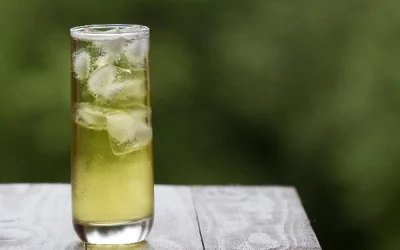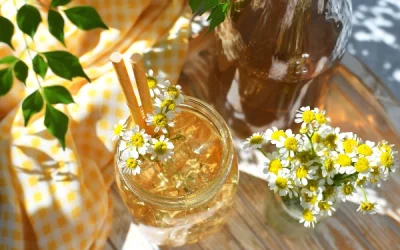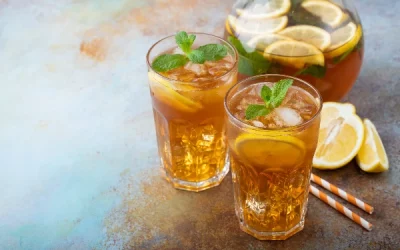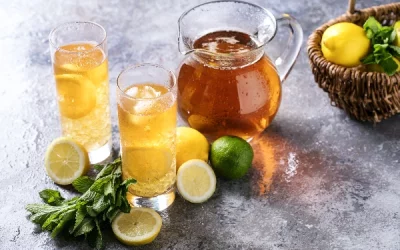Have you ever sipped a perfectly brewed iced tea on a warm day and wondered how to recreate that delicious experience at home? Iced tea is not just a refreshing drink; it’s a versatile favourite that can be customised to suit anyone’s taste. In this guide, we’ll explore everything you need to know about making iced tea, from selecting the right leaves to serving suggestions. Get ready to elevate your home beverage game and enjoy the myriad health benefits that iced tea brings!
Table of Content
- What are the basic steps to make iced tea?
- How do different tea varieties affect the flavour of iced tea?
- What are the best methods for brewing iced tea?
- How can you customise the flavour of iced tea?
- What are the health benefits of iced tea?
- How can you achieve the perfect sweetness in iced tea?
- What are the best tips for serving and garnishing iced tea?
- What are some common mistakes to avoid when making iced tea?
- Conclusion
What are the basic steps to make iced tea?
Making iced tea at home can be both fun and rewarding. Follow these steps and you’ll be sipping on a refreshing glass in no time. First, let’s start with selecting the right tea leaves. From there, we’ll move on to brewing methods, chilling techniques, sweetening options, and some serving suggestions that will make your iced tea the star of any gathering.
Choosing the right tea leaves is crucial. Consider traditional black tea, which provides a strong and classic flavour. If you prefer lighter notes, green tea is an excellent choice. For a fruity and herbal touch, try oolong or even hibiscus tea. Once you’ve selected your tea, it’s time to brew it.
What type of tea leaves are best for iced tea?
When choosing the best tea leaves for iced tea, it’s all about the flavour and durability of the leaves. The type you select can significantly influence the final taste of your drink. Here are some options to consider:
- Black tea: This tea offers a bold and robust flavour, making it a popular choice for iced tea.
- Green tea: Lighter and more delicate, green tea provides a refreshing and slightly grassy flavour.
- Oolong tea: Somewhere between black and green tea, oolong offers a unique and complex taste.
- Herbal teas: These can include hibiscus, chamomile, or mint, adding fruity or floral notes.
Remember, fresh and high-quality tea leaves will always give a better flavour. Now, let’s move on to the brewing process.
Once you’ve chosen your tea, the next step is to brew it. Use freshly boiled water and steep your tea leaves for the right amount of time.
How long should you steep the tea?
Steeping time is crucial as it directly affects the taste and strength of your iced tea. Here are some general guidelines depending on the type of tea:
- Black tea: Steep for 3 to 5 minutes.
- Green tea: Steep for 2 to 3 minutes.
- Oolong tea: Steep for 4 to 7 minutes.
- Herbal teas: Steep for 5 to 7 minutes.
- Ensure you don’t oversteep, as this can make the tea bitter.
- Use a timer to keep track of steeping time.
- Adjust the steeping time according to your taste preference – longer for stronger tea, shorter for lighter tea.
- Strain the tea leaves immediately after steeping to stop the brewing process.
Now that the tea is brewed, you’ll need to chill it properly.
What are the best methods to chill the tea?
Chilling your iced tea can make or break its final taste. There are several effective methods to make sure it’s just right:
- Ice method: Pour the hot tea directly over a pitcher full of ice cubes. This cools the tea quickly but can dilute it.
- Refrigerator method: Allow the tea to cool at room temperature and then refrigerate it for a few hours.
- Ice water bath: Place the hot tea container in a larger bowl filled with ice water to speed up the cooling process.
- Flash chilling: Use a cocktail shaker with ice to instantly chill the tea – great for small batches.
Let’s not forget to sweeten and serve your tea for the best experience.
- Sweeten the tea while it’s hot to ensure the sugar dissolves completely.
- Use honey, agave syrup, or stevia as alternative sweeteners.
- Serve the iced tea in tall glasses with fresh mint or lemon slices.
- Add fruits like berries or peach slices for extra flavour.
In 1904, iced tea became popular during the World’s Fair in St. Louis. Richard Blechynden, who was trying to sell hot tea on a very hot day, decided to serve it over ice. People loved it, and iced tea’s popularity has grown ever since.
I remember making my first iced tea during a scorching summer in Copenhagen. I experimented with different types of teas and finally settled on a blend of black and oolong. I chilled it using the ice water bath method, which worked wonders. Adding a hint of honey and slices of fresh lemon made it the perfect cool drink, and my friends couldn’t get enough of it!
I hope these tips help you create your perfect iced tea. Enjoy!
How do different tea varieties affect the flavour of iced tea?
When making iced tea, the type of tea leaves you use can significantly change the flavour. Whether you choose black, green, or herbal tea, each variety offers a unique taste experience. Iced tea can vary from strong and bold to light and refreshing, just based on the choice of tea. The table below will help you understand how different tea varieties impact the final brew.
To use the table, check the “Tea Variety” column to identify the type of tea you’re interested in. The “Steeping Time” column shows how long you need to steep the tea for the best flavour. The “Flavour Profile” gives you an idea of what the tea will taste like, and the “Ideal Pairings” column offers suggestions for foods or additives that complement each tea’s flavour.
| Tea Variety | Steeping Time | Flavour Profile | Ideal Pairings |
|---|---|---|---|
| Black Tea | 5-7 minutes | Bold, robust, earthy | Lemon, honey, mint |
| Green Tea | 3-4 minutes | Fresh, grassy, slightly bitter | Lemon, ginger, berries |
| Oolong Tea | 4-6 minutes | Floral, smooth, complex | Peaches, honey, jasmine |
| Herbal Tea | 5-7 minutes | Fruity, floral, varied | Mint, citrus fruits, honey |
| White Tea | 3-5 minutes | Delicate, sweet, lightly floral | Melon, cucumber, mint |
| Rooibos Tea | 6-8 minutes | Sweet, nutty, full-bodied | Vanilla, berries, cinnamon |
| Chamomile Tea | 5-6 minutes | Floral, slightly sweet, calming | Lemon, honey, lavender |
Types of teas to consider for making iced tea
There’s a dazzling array of teas you can use to make iced tea. Each tea variety brings its unique taste and aroma due to its unique composition and processing methods. Here’s an overview of some common tea types:
- Black Tea: Known for its strong and robust flavour. Ideal for a refreshing, bold iced tea.
- Green Tea: Offers a lighter taste with a fresh and slightly bitter note.
- Oolong Tea: Sits somewhere between black and green tea, and has a smooth, complex flavour profile.
- Herbal Tea: These are not true teas but are infusions of herbs, flowers, and fruits. They offer varied flavours from fruity to floral.
- White Tea: Known for its delicate sweetness and lightly floral notes.
- Rooibos Tea: This herbal tea has a sweet, nutty flavour that’s quite full-bodied.
- Chamomile Tea: Another herbal option with calming floral notes.
Understanding the uniqueness of each tea type can help you choose the right tea for your iced tea, catering to your taste preferences and pairing with food or additives accordingly.
Pairing suggestions for iced tea
Pairing your iced tea with the right additions or foods can elevate the drinking experience. Some great pairing suggestions include:
- Black Tea: Lemon adds a zesty taste, and honey brings sweetness. Mint gives it a refreshing twist.
- Green Tea: Lemon brightens the flavours, ginger adds a bit of spice, and berries offer a sweet contrast.
- Oolong Tea: Peaches can add a juicy sweetness, honey enhances flavours, and jasmine adds an extra floral note.
- Herbal Tea: Mint adds freshness, citrus fruits give an acidic contrast, and honey offers a natural sweetness.
- White Tea: Melon and cucumber can enhance the delicate sweetness, while mint adds a refreshing touch.
- Rooibos Tea: Vanilla gives it a rich, creamy finish, berries add a fruity note, and cinnamon brings warmth.
- Chamomile Tea: Lemon brings a bright, tangy note, honey enhances the sweetness, and lavender can add a soothing aroma.
Exploring these pairings can help you find your perfect iced tea match, making your homemade brew not only refreshing but also tailor-made for your palate.
Back in the 1900s, Iced tea rose to popularity in the United States, thanks to its refreshing nature. An interesting story lies in the 1904 World’s Fair in St. Louis. Richard Blechynden, a tea plantation owner, tried to serve hot tea to the fair attendees. However, the intense heat led him to a creative solution: he decided to serve the tea cold. Attendees loved the new drink, and iced tea rapidly gained popularity.
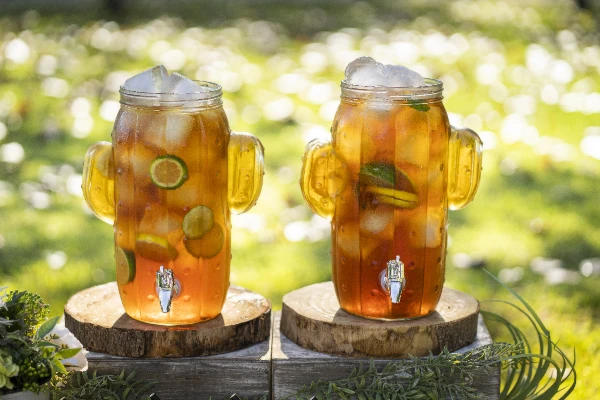
What are the best methods for brewing iced tea?
Brewing iced tea might seem as simple as plonking a tea bag in water and chucking in some ice. But hang on, there’s more to it if you genuinely want to savour the experience. There are mainly three methods to brew iced tea: hot brewing, cold brewing, and sun tea. Let’s dive into each, shall we?
When it comes to hot brewing, think of it as the quick and efficient way to get it done. Boil your water, steep the tea, and you’re halfway there. Just don’t add flaming hot tea to ice straight away unless you enjoy a diluted mess. Cold brewing, on the other hand, is a slow-burner. It involves patience as your tea leisurely infuses overnight. However, the result is a smooth, less bitter concoction. And finally, sun tea: leave it to soak sunlight for several hours, just rock that classic Mason jar vibe.
What is the difference between hot brewing and cold brewing?
Ah, the classic battle of hot versus cold. When it comes to brewing iced tea, both methods have their bragging rights, and here’s how they differ:
Hot Brewing
- Brewing Temperature: Hot water, win the game. 90°C to 100°C will do the trick.
- Brewing Time: Usually 3-5 minutes. Quick and straightforward.
- Equipment Needed: Kettle for boiling, tea pot or your regular mug, strainer.
- Advantages: Rapid method. You can adjust the strength easily.
- Drawbacks: Can turn bitter if steeped too long or too strong.
Yes, hot brewing is all about speed and convenience. But it demands attention. Overdo it, and you’re left with a tea that bites back.
Cold Brewing
- Brewing Temperature: Room temperature or refrigerated water. Zero heat.
- Brewing Time: A patient 8 to 12 hours. Trust me, it’s worth it.
- Equipment Needed: Large pitcher, refrigerator space, strainer.
- Advantages: Smooth and mellow taste with less bitterness. Perfect for delicate teas.
- Drawbacks: Time-consuming. Requires planning ahead.
Cold brewing is the zen master of tea-making. It takes time, but the result is a virtually foolproof smooth iced tea. You’ll have less bitterness and enjoy a subtler yet refreshing sip.
How does sun tea differ from other methods?
Sun tea, my dear friend, takes a beautifully simple and earthy approach. It’s like cold brewing but powered by a giant celestial body:
Sun Tea
- Brewing Temperature: Ambient temperature broth kissed by the sun.
- Brewing Time: 3-5 Hours in direct sunlight.
- Equipment Needed: A large clear jar (a Mason jar’s a classic), lid or cover, sunlight.
- Advantages: No need for boiling water or fridge space, utilises natural energy.
- Drawbacks: Potential for bacterial growth if not careful.
Sun tea has this rustic charm – harnessing nature’s warmth rather than an electric kettle. However, always ensure you do it safely. Keeping it fresh and refrigerating immediately after brewing is key because no one wants a surprise bacterial culture in their drink.
What equipment is necessary for each method?
Equipment, my friend, can make or break your tea-making mission. Let’s check out the gears needed for each brewing method:
Hot Brewing
- Kettle: For boiling water fast and efficiently.
- Teapot: Preferably with a good infuser; otherwise, a mug will suffice.
- Strainer: To keep out those pesky loose leaves.
- Jug and Ice: For chilling purposes.
Cold Brewing
- Large Pitcher: The more generously sized, the better.
- Refrigerator: Your sanctuary for that long cool brew.
- Strainer: Because nobody likes a leafy mess.
- Optional Sweetener: Honey, sugar, or whatever tickles your fancy.
Sun Tea
- Clear Mason Jar: For that perfect sun tea aesthetic.
- Lid/Cover: To keep those bugs at bay.
- Sunlight: Not an equipment per se, but it’s the star of the show.
- Refrigerator: For cooling and safe storage after brewing.
With the right equipment, your iced tea journey can be smooth sailing. Avoid shortcuts, and invest in good-quality gear.
How can you customise the flavour of iced tea?
Alright, fellow iced tea aficionados, if you’re tired of the same old, boring, plain iced tea then you’re in for a treat. Let’s jazz up that basic brew. You can turn your iced tea from drab to fab with fruits, herbs, spices, sweeteners, and flavoured syrups. Let’s break it all down so you can impress your friends and feel like a tea wizard in your own home.
Fruits, for instance, not only bring a natural sweetness but also add a colourful garnish that’s Insta-worthy. Herbs like mint and basil can make your tea refreshingly aromatic. Spices such as cinnamon and ginger can give your tea a cosy vibes, perfect for those who want a bit more warmth. Sweeteners and flavoured syrups are like the cherry on top, taking your tea from good to “OMG, I need this recipe!”.
What fruits can be added to iced tea for flavour?
When it comes to adding fruits, it’s like taking your tea on a holiday. Here’s the lowdown on what fruits to toss into your jug of iced tea to turn it into a fiesta of flavours:
- Lemons and Limes: Bringing the zing, these citrus fruits lift the freshness to another level.
- Berries: Think strawberries, blueberries, or raspberries. Not only do these add a pop of colour but they infuse your tea with a juicy sweetness.
- Peaches: Adding peaches makes your tea taste like summer in a glass.
- Oranges: These give a sweet, tangy twist, perfect for those who love a little punch.
- Mangoes: For a tropical spin, mangoes offer a rich, exotic sweetness.
Chuck in a handful of any of these fruits, and your iced tea will thank you.
How do herbs like mint and basil enhance the taste?
Now let’s talk herbs – the unsung heroes of iced tea. Adding fresh herbs to your iced tea isn’t just a posh move; it’s a taste explosion waiting to happen.
- Mint: This classic herb brings a refreshing, cool kick that’s perfect for hot days.
- Basil: Totally underrated but basil offers a sweet, slightly peppery taste that pairs brilliantly with citrus fruits.
- Lavender: A bit adventurous, sure, but lavender gives a subtle floral note that’s calming and aromatic.
- Rosemary: Offers a piney, earthy hint that works wonders especially with lemon.
- Thyme: Light and slightly minty, thyme is a great duet partner for fruits like berries and peaches.
Adding these herbs can make your iced tea not only taste better but smell phenomenal.
What are some popular spices to use in iced tea?
So you’re a spice enthusiast, well you’re in for a scrumptious ride. Spices can give your iced tea an exotic twist, adding a warmth that dances on your tongue. Let’s get into some of the favourites:
- Cinnamon: Perfect for a sweet and spicy combo; leaves a lingering warmth.
- Ginger: Adds a zingy, spicy note that’s invigorating and refreshing.
- Cardamom: Brings a floral, sweet yet pungent flavour that elevates the taste.
- Cloves: These tiny spices add a warm, aromatic twist, great for cooler days.
- Star Anise: A unique, licorice-like flavour that’s both sweet and spicy, ideal for the adventurous palate.
Adding spices to your iced tea might sound odd initially, but once you try it, you’ll never go back.
During the American Prohibition in the 1920s, iced tea surged in popularity partly because it provided a sophisticated alternative to the banned alcoholic drinks. Speakeasies (those secret, illicit establishments) would often serve iced tea in fancy glasses to give patrons a taste of elegance amidst the gloom of Prohibition.
So, basically, iced tea helped people keep their cool – literally and figuratively. Now you can channel that same vibe in your own home, no secret passwords needed!
So, there you go – load up your iced tea with fruits, herbs, and spices and get ready to bask in the compliments. Happy brewing!
What are the health benefits of iced tea?
Pouring yourself a chilled glass of iced tea isn’t just about beating the heat. Oh no, this liquid gold is packed full of benefits that go beyond simple refreshment. Imagine antioxidants partying in your body, keeping things youthful while ensuring you stay hydrated without the guilt of heavy calories. But like all good things, there are a few potential pitfalls to keep in mind. Let’s break it down:
First off, antioxidants are your best friends here. These molecules help combat oxidative stress and reduce inflammation. Plus, when it comes to hydration, iced tea can be your trusty sidekick. It’s like drinking water but with a flavourful twist. Sprinkle in the fact that it’s low in calories if you skip sugary add-ins, and you’ve got a beverage that’s both tasty and waistline-friendly.
However, there’s always a “but.” Overdoing it could lead to unwanted side effects. Much like that one friend who’s great in small doses but too much can leave you reeling. Want to know more? Read on!
What antioxidants are found in iced tea?
Antioxidants are more than just a buzzword; they’re the unsung heroes in your glass. Iced tea, whether it’s black or green, has different types of antioxidants that pack a punch against free radicals.
- Flavonoids: These are found in abundance and include catechins, theaflavins, and thearubigins.
- Polyphenols: Offering anti-inflammatory and anti-carcinogenic properties.
- EGCG (Epigallocatechin gallate): Especially abundant in green tea, it’s known for its health-boosting powers.
- Quercetin: An antioxidant that contributes to heart health.
- Tannins: Have a role in improving digestive health.
Each of these antioxidants helps your body in different ways. They improve immune function, protect your cells, and may even help in staving off chronic diseases. It’s like having a tiny army in your body!
How does iced tea contribute to hydration?
Imagine you’re a parched traveller in a desert, and then someone hands you a glass of iced tea. Relief, right? That’s hydration. When it comes to keeping you hydrated, iced tea does a pretty decent job – potentially better than some other options.
- Water Content: The high water content helps maintain fluid balance.
- Hydration Variety: Offers an alternative to plain water, making staying hydrated less monotonous.
- Electrolytes: Some herbal varieties have electrolytes that can help you bounce back after a workout.
- Caffeine Content: While minimal, the caffeine helps wake you up without dehydrating you like stronger caffeinated beverages.
- Versatile Temperature: Whether you drink it super cold or just cool, it still does its job.
Sure, it’s not a magic potion, but it certainly beats chugging yet another glass of boring old H2O. Plus, hydration is essential for everything, from glowing skin to efficient bodily functions. So, why not make it tasty?
Are there any potential health drawbacks to drinking iced tea?
Hold your horses; before you start guzzling pitchers of iced tea like there’s no tomorrow, let’s add a dash of realism. Too much of anything is problematic, and iced tea is no exception.
- Sugar Content: Adding too much sugar or choosing pre-sweetened versions can turn a healthy drink into a sugar bomb.
- Caffeine: Even though it’s lower than in coffee, caffeine can still cause insomnia or jitters in high amounts.
- Oxalates: Certain teas have high oxalate levels, which can lead to kidney stones if consumed in excessive amounts.
- Acidic Nature: Overindulgence might affect dental health or lead to acid reflux in sensitive individuals.
- Additives: Sometimes, store-bought varieties contain artificial flavours, colours, or preservatives, which aren’t exactly health-friendly.
In moderation, iced tea is a superstar. Just don’t undo its benefits by turning it into a sugary, calorific nightmare.
During the Boston Tea Party in 1773, colonists dumped an entire shipment of tea into the harbour to protest the Tea Act. Imagine if they had known about iced tea – they might have thought twice before wasting such potential for refreshment and health.
That revolutionary spirit wasn’t just about making a political statement; it could’ve also been about making healthier choices! Who knew the history of tea could be so intertwined with health benefits and protest?
How can you achieve the perfect sweetness in iced tea?
Achieving the perfect sweetness in iced tea boils down to balancing the right sweeteners, knowing the right timing, and avoiding common pitfalls. Let’s break it down, shall we?
First off, you’ve got your sweeteners. There’s the classic granulated sugar, a no-brainer that’s found in every cupboard. But we’re not stopping there – you can also flex your culinary muscles with honey, agave syrup, or even funky stuff like stevia or monk fruit.
Each has its own quirk and character, flavouring your iced tea like Picasso on a canvas. And then, there’s the question of when to add these sweet morsels. Timing is everything – add them too early and risk dilution; too late, and you’ll be fighting sugar crystals.
Now, for all you health-conscious warriors out there, sugar-free options have you covered without missing a beat. Artificial sweeteners, flavoured tie-ins, and natural alternatives can make your iced tea both tasty and guilt-free.
And let’s not forget the classic blunders like over-sweetening or using sweeteners that don’t dissolve properly. Avoid these like the plague, and you’ll be golden (or in this case, amber).
What are the best sweeteners for iced tea?
You’ve got tonnes of options here, and each has its own star quality. Here’s the rundown:
- Granulated Sugar: Standard, and reliable. Dissolves best in hot tea.
- Honey: Brings a richer, more complex flavour. Ideal for those who like a bit of luxury.
- Agave Syrup: Smooth sweetness with a low glycaemic index. Good for the health buffs.
- Stevia: The calorie-free natural alternative. No sugar spikes here.
- Monk Fruit: Another zero-calorie option, extracted from fruit. Sweet and health-conscious.
- Coconut Sugar: Adds a hint of caramel. Fancy, right?
- Maple Syrup: Perfect if you’re feeling particularly Canadian. Sweet and unique.
Different sweeteners work better with different flavours of tea. Play around to find your perfect match.
When is the best time to add sweeteners to iced tea?
Timing your sweetener addition is like catching a wave – get it just right, and it’s smooth sailing:
- While Brewing: Add your sweetener while the tea is hot. Best for granulated sugar and honey as they dissolve easily.
- After Brewing: If you missed adding sweeteners during brewing, no worries. Liquid sweeteners like agave or simple syrup work best.
- At Serving: Customise each glass as you serve. Perfect for those picky guests who like to control their sugar levels.
- For Cold-Brewing: Use liquid sweeteners after the tea has brewed since cold temperatures make dissolving tricky.
Be aware! Adding too late means you’ll stir forever trying to dissolve sugar, and it still might settle at the bottom.
How can you make a sugar-free iced tea?
Loving iced tea but hate the sugar overload? We’ve got some nifty tricks to keep it sweet without the white granules:
- Use Stevia or Monk Fruit: Natural, zero-calorie, and gets the job done.
- Fruit Infusions: Add berries, peaches, or citrus slices. They’ll sweeten naturally.
- Flavoured Teas: Choose pre-flavoured teas like peach or berry, which bring in natural sweetness.
- Spices and Herbs: Mint, cinnamon sticks, or a hint of vanilla extract can add a natural, no-calorie sweetness.
- Cold-Brew: Brewing your tea in cold water can produce a naturally milder and sweeter flavour.
And remember, experimenting can be fun – who knows, you might invent the next big thing in sugar-free tea.
Here’s a little gem from history: In the early 1900s, iced tea burst onto the scene at the 1904 World’s Fair in St. Louis. It was a scorching summer, and a tea vendor couldn’t sell his piping hot tea. A stroke of genius struck – he poured it over ice.
Voilà! Iced tea was an instant hit. Plus, back then, sweeteners weren’t as varied or health-conscious as today. So, while we enjoy our artisan sweeteners and refined methods, it’s humbling to think it all started with some ice cubes and a hot day.
So there you go! Whether you’re a traditionalist with a sweet tooth or a health guru looking to cut calories, perfecting the sweetness in your iced tea is an art.
What are the best tips for serving and garnishing iced tea?
Serving and garnishing iced tea isn’t just about dumping some tea into a glass and calling it a day. Nope, it’s about creating an experience. Presentation is key, and the taste? Even more so! So if you want to wow your guests or just feel fancy while sipping on your patio, here are some pro tips you need to know.
Firstly, glassware is crucial. Ever noticed how drinks just seem to taste better when served in a pretty glass? Yep, that’s not a coincidence. Next up, the type of ice you use can actually make or break your iced tea game. And don’t get me started on garnishes. Fruits, herbs, edible flowers—you’ve got options, and they all add that extra zing. Plus, who doesn’t want their drink to look Instagram-worthy?
What type of glassware is best for serving iced tea?
Ah, glassware—the unsung hero of a good drink. For iced tea, you want something that’s big enough to hold a decent amount of liquid and ice, yet elegant enough to make you feel like you’re dining at a five-star restaurant.
- Tall Glasses: Think highball or Collins glasses. They’re great for showcasing those layers of tea, ice, and garnishes.
- Mason Jars: If you’re going for the rustic, country look, mason jars are your best mates. They also hold a lot of liquid, so perfect for those really hot days.
- Tumbler Glasses: These are versatile and great if you want something a bit more casual but still stylish.
- Stemless Wine Glasses: Want to be fancy but not too fancy? Stemless wine glasses strike the right balance.
- Pitchers: Not for individual servings, but if you’re hosting a party, a large glass pitcher with a spout is both functional and good-looking.
Each of these options will elevate your iced tea from basic to brilliant, making you the envy of the neighbourhood.
How does the type of ice used affect the drink?
Now, let’s talk ice. It’s more important than you think. Ice does more than just chill your drink; it can actually influence the taste and presentation.
- Crushed Ice: Perfect for a quick chill but melts faster, potentially watering down your tea.
- Ice Cubes: Standard, no-frill option that’s dependable. They keep your drink cool without diluting it too quickly.
- Sonic Ice: Also known as nugget ice or pellet ice, these are small, chewable pieces that people absolutely love. It’s a hit in fancy bars for a reason.
- Flavoured Ice Cubes: Freeze some iced tea or fruit juice into cubes. These not only keep your drink cold but also add a burst of flavour as they melt.
- Clear Ice: Fancy but worth it if you have the patience. It’s denser and melts slower, keeping your drink from getting watered down too quickly.
Choosing the right type of ice can make your iced tea experience that much better. Trust me, once you nail this, there’s no going back.
What are some creative garnishes for iced tea?
Now, let’s get artsy. Garnishes are where you can really let your creativity shine. They not only add a pop of colour but can also enhance the flavour of your tea.
- Lemon or Lime Slices: Classic but effective. Adds a zesty kick and looks great.
- Fresh Herbs: Mint, basil, or rosemary work wonders. They add a fresh aroma and a subtle flavour boost.
- Edible Flowers: Lavender, hibiscus, and pansies aren’t just pretty; they bring a unique taste as well.
- Fruit Skewers: Pop some berries, melon balls, or citrus segments on a stick for a vibrant touch.
- Cucumber Slices: They add a spa-like freshness that’s just so refreshing.
With these garnishes, your iced tea won’t just taste good—it’ll look like a masterpiece. Think of it as tea-making elevated to an art form.
So there you have it! Serve your iced tea like a pro, wow with the best garnishes, and keep your ice game strong. Cheers to making the simplest things extraordinary!
What are some common mistakes to avoid when making iced tea?
Alright, let’s be real. Iced tea might seem like it’s just tea with ice, but there’s a fine line between sipping bliss and swamp water. Here are the common blunders people make and how you can dodge them like a pro.
What happens if you over-steep the tea?
Over-steeping your tea is just about the cardinal sin of iced tea making. If you’ve ever wondered why some iced teas have that lovely, grassy bitterness which makes you want to spit it out, it’s because someone left the tea to steep for too long.
Ideally, you should:
- Keep an eye on the clock. Usually, 3 to 5 minutes does the job.
- Use a timer if you’re prone to getting distracted by, oh I don’t know, cat videos.
- Opt for cold brewing as an alternative. It takes longer but the flavour is smoother.
- Steep in small batches so you have more control.
- Follow the recommended steeping time on the tea package. These people know what they’re talking about.
Under-steeping, on the other hand, might as well be water dressed as tea. Balance is the key to getting that perfect brew.
Why is water quality important for iced tea?
Let’s face it; the best tea leaves won’t save your iced tea if you’re using water that tastes like it came from a rusty pipe. For the best results:
- Use filtered or bottled water if your tap water tastes off.
- Avoid using water with high mineral content, as it can alter the flavour.
- Always use fresh, cold water; never reboil water as it loses oxygen and affects taste.
- If you’re unsure about your water’s quality, make a small test batch.
- Taste the water before using it. If it smells or tastes funky, consider another source.
Good water is like the wingman of your iced tea. It brings out the best in the leaves.
How can you avoid incorrect sweetening?
Sweetening your iced tea can be as tricky as delivering a punchline. Too little sugar and it’s bland, too much and you might as well call it syrup. Here’s how to nail it:
- Sweeten while the tea is still hot. Sugar dissolves better in hot liquid.
- Use simple syrup if you want an even consistency.
- Start small and taste as you go. It’s easier to add more sweetness than to remove it.
- Consider using honey, agave syrup, or stevia for a different flavour profile.
- Balance the sweetness with a dash of lemon or other citrus fruits.
That way, you won’t end up with a sugar coma in a glass.
If you’re ever experimenting with herbs or fruits, remember the backbone of any good iced tea is balance. No one likes a drink that’s all brawn and no brains. Speaking of balance, improper chilling is another pitfall. Not letting your tea cool down before adding ice means you’ve just invited rapid dilution to your party. Let the brew chill in the fridge first.
Oh, and for the love of all that is refreshing, avoid using pre-packed, artificial flavour sachets. Natural flavours like lemon, mint, or berries offer a fresher, more authentic taste.
Conclusion
In closing, I’ve explored the multifaceted world of iced tea, from the fundamental steps of brewing to the myriad ways we can customise and perfect our chilled beverages. The artistry of making iced tea commences with selecting the right tea leaves and mastering the chilling process, both of which set the foundation for an enjoyable drink. As we delve into the flavour profiles offered by different tea varieties, it becomes clear that each option brings a unique character to our creations, allowing us to craft personalised refreshments that can delight any palate.
The brewing methods, whether hot, cold, or sun tea, each have their merits and nuances, highlighting the versatility of this beverage. Customisation with fruits, herbs, and spices opens up an exciting avenue for innovation, providing endless possibilities to enhance flavour and presentation. Furthermore, the health benefits of iced tea remind us of its nourishing qualities, making it not only a delicious choice but a health-conscious one as well.
As you embark on your iced tea-making adventures, remember to experiment with sweetening options and presentation techniques to elevate your experience even further. Be mindful of the common mistakes we’ve discussed to ensure that each batch is just as delightful as the last.
Ultimately, making iced tea at home is not just about the drink itself; it’s about creating an experience that brings people together. As you sip your refreshing creation, I invite you to reflect on how this simple pleasure can transform a hot day into a cherished moment.
After all, what better way to unwind than with a glass of iced tea, knowing it was crafted with thought and care? As I often remind myself, the perfect cup of iced tea is not just a drink; it’s a celebration of flavours, memories, and the joy of sharing.
Resources
- Low-calorie sweeteners and human health: a rapid review of systematic …
- Expert consensus on low-calorie sweeteners: facts, research gaps and …
- Antioxidants from black and green tea: from dietary modulation of …
- Impact of Cold versus Hot Brewing on the Phenolic Profile and …
- Tea consumption in relation with metabolic syndrome and obesity: A …
- Antioxidant mechanism of tea polyphenols and its impact on health benefits



